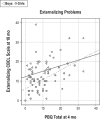The role of infant sleep in intergenerational transmission of trauma
- PMID: 21966069
- PMCID: PMC3174839
- DOI: 10.5665/SLEEP.1282
The role of infant sleep in intergenerational transmission of trauma
Abstract
Introduction: Children of parents who experienced trauma often present emotional and behavioral problems, a phenomenon named inter-generational transmission of trauma (IGTT). Combined with antenatal factors, parenting and the home environment contribute to the development and maintenance of sleep problems in children. In turn, infant sleep difficulty predicts behavioral and emotional problems later in life. The aim of this study was to investigate whether infant sleep problems predict early behavioral problems indicative of IGTT.
Methods: 184 first-time mothers (ages 18-47) participated. N=83 had a history of childhood abuse and posttraumatic stress disorder (PTSD+); 38 women reported childhood abuse but did not meet diagnostic criteria for PTSD (PTSD-); and the control group (N=63) had neither a history of abuse nor psychopathology (CON). Depression, anxiety, and sleep difficulty were assessed in the mothers at 4 months postpartum. Infant sleep was assessed using the Child Behavior Sleep Questionnaire (CSHQ). Outcome measures included the Parent Bonding Questionnaire (PBQ) at 4 months and the Child Behavior Check List (CBCL) at 18 months.
Results: Infants of PTSD+ mothers scored higher on the CSHQ and had more separation anxiety around bedtime than PTSD- and CON, and the severity of their symptoms was correlated with the degree of sleep disturbance. Maternal postpartum depression symptoms mediated impaired mother-infant bonding, while infant sleep disturbance contributed independently to impaired bonding. Mother-infant bonding at 4 months predicted more behavioral problems at 18 months.
Conclusions: Infant sleep difficulties and maternal mood play independent roles in infant-mother bonding disturbance, which in turn predicts behavioral problems at 18 months.
Keywords: Child abuse; PTSD; depression; development.
Figures




Similar articles
-
Psychopathology and parenting: An examination of perceived and observed parenting in mothers with depression and PTSD.J Affect Disord. 2017 Jan 1;207:242-250. doi: 10.1016/j.jad.2016.08.035. Epub 2016 Oct 3. J Affect Disord. 2017. PMID: 27732922 Free PMC article.
-
Mother-infant bonding impairment across the first 6 months postpartum: the primacy of psychopathology in women with childhood abuse and neglect histories.Arch Womens Ment Health. 2013 Feb;16(1):29-38. doi: 10.1007/s00737-012-0312-0. Epub 2012 Oct 12. Arch Womens Ment Health. 2013. PMID: 23064898 Free PMC article.
-
Understanding Bidirectional Mother-Infant Affective Displays across Contexts: Effects of Maternal Maltreatment History and Postpartum Depression and PTSD Symptoms.Psychopathology. 2016;49(4):305-314. doi: 10.1159/000448376. Epub 2016 Sep 1. Psychopathology. 2016. PMID: 27576477 Free PMC article.
-
Perinatal depression, PTSD, and trauma: Impact on mother-infant attachment and interventions to mitigate the transmission of risk.Int Rev Psychiatry. 2019 May;31(3):245-263. doi: 10.1080/09540261.2018.1563529. Epub 2019 Feb 27. Int Rev Psychiatry. 2019. PMID: 30810410 Review.
-
Afraid and Awake: The Interaction Between Trauma and Sleep in Children and Adolescents.Child Adolesc Psychiatr Clin N Am. 2021 Jan;30(1):225-249. doi: 10.1016/j.chc.2020.09.002. Epub 2020 Oct 27. Child Adolesc Psychiatr Clin N Am. 2021. PMID: 33223064 Review.
Cited by
-
First-Time Parents' Bonding with Their Baby: A Longitudinal Study on Finnish Parents during the First Eight Months of Parenthood.Children (Basel). 2023 Nov 14;10(11):1806. doi: 10.3390/children10111806. Children (Basel). 2023. PMID: 38002897 Free PMC article.
-
Mind-mindedness in mothers of infants with excessive crying/sleeping/eating disorders.Front Child Adolesc Psychiatry. 2024 May 23;3:1331016. doi: 10.3389/frcha.2024.1331016. eCollection 2024. Front Child Adolesc Psychiatry. 2024. PMID: 39816608 Free PMC article.
-
Intergenerational Trauma: Assessment in Biological Mothers and Preschool Children.J Child Adolesc Trauma. 2021 Aug 17;15(2):307-317. doi: 10.1007/s40653-021-00397-3. eCollection 2022 Jun. J Child Adolesc Trauma. 2021. PMID: 35600526 Free PMC article.
-
Adverse childhood experiences are associated with adult sleep disorders: a systematic review.Sleep Med. 2015 Mar;16(3):320-30. doi: 10.1016/j.sleep.2014.12.013. Epub 2015 Jan 21. Sleep Med. 2015. PMID: 25777485 Free PMC article.
-
State of the science of maternal-infant bonding: a principle-based concept analysis.Midwifery. 2013 Dec;29(12):1314-20. doi: 10.1016/j.midw.2012.12.019. Epub 2013 Feb 27. Midwifery. 2013. PMID: 23452661 Free PMC article. Review.
References
-
- Anders TF, Eiben LA. Pediatric sleep disorders: a review of the past 10 years. J Am Acad Child Adolesc Psychiatry. 1997;36:9–20. - PubMed
-
- Schwichtenberg AJ, Goodlin-Jones B. Causes and correlates of frequent night awakenings in early childhood. Int Rev Neurobiol. 93:177–91. - PubMed
-
- Richman N. A community survey of characteristics of one- to two-year-olds with sleep disruptions. J Am Acad Child Psychiatry. 1981;20:281–91. - PubMed
Publication types
MeSH terms
Grants and funding
LinkOut - more resources
Full Text Sources
Molecular Biology Databases

